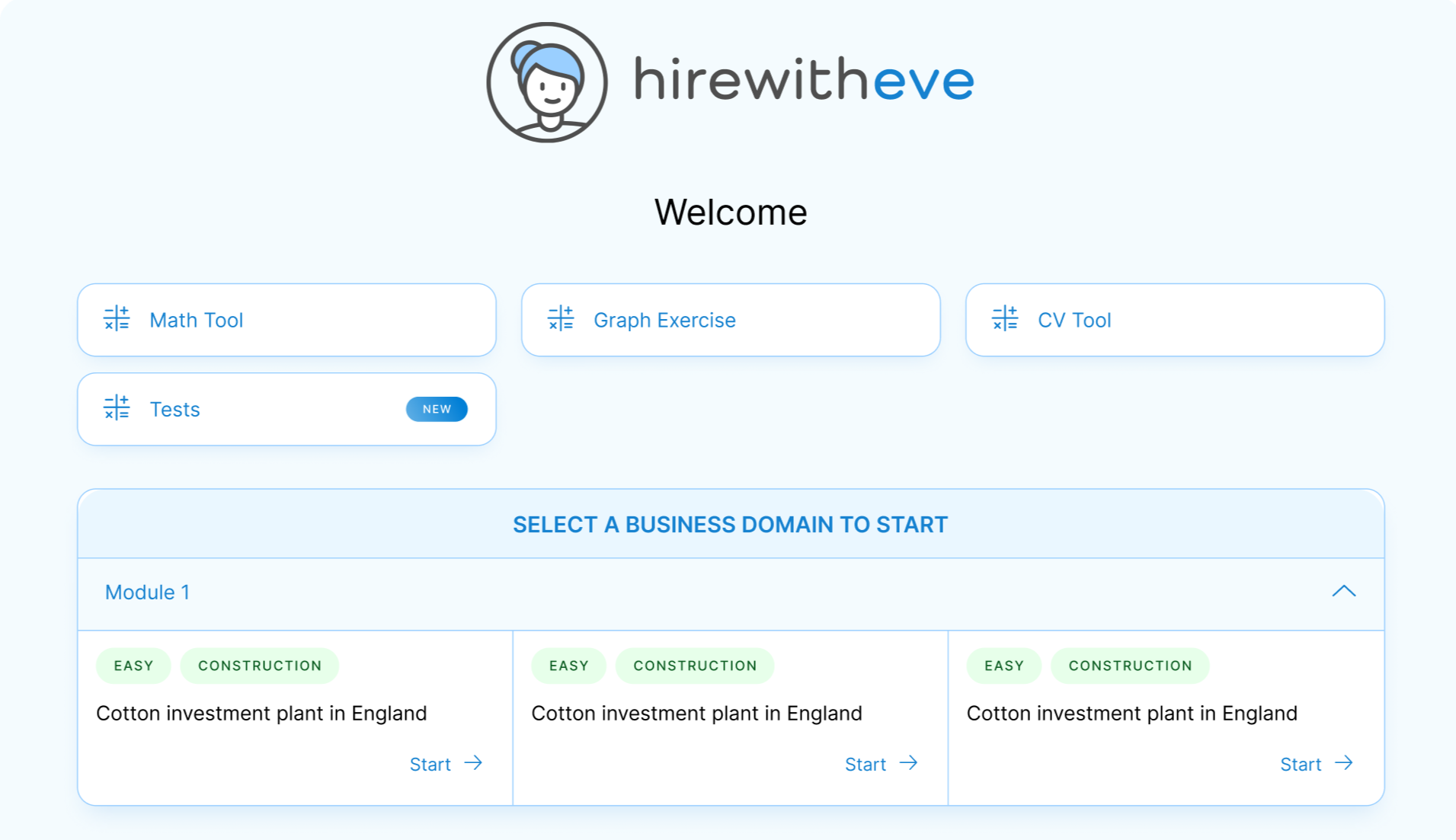Enhancing Problem-Solving Skills in Hiring

Share
The Importance of Problem-Solving Skills in the Workplace
In today’s dynamic business environment, problem-solving skills are indispensable. Every role, from entry-level positions to executive management, requires the ability to navigate challenges and devise effective solutions. Employers seek candidates who can demonstrate these skills as they contribute significantly to organizational success.
The Challenge of Assessing Problem-Solving Skills in Interviews
Despite their importance, evaluating problem-solving skills during interviews remains challenging. Traditional interview questions often fail to capture a candidate’s true ability to tackle real-world problems. This article aims to bridge this gap by providing talent acquisition specialists and HR managers with innovative problem-solving interview questions and showcasing how HirewithEve can enhance the hiring process.
Table of contents
Why Problem-Solving Skills Matter in Every Job
The Problem with Traditional Interview Techniques
Crafting the Right Problem-Solving Questions
12 Essential Problem-Solving Interview Questions and Sample Answers
Enhancing Interviews with HirewithEve
Combining Problem-Solving Questions with Targeted Skills Testing
Examples of HirewithEve Assessments
How to Use HirewithEve Effectively
FAQs about Problem-Solving Interview Questions
Conclusion
Why Problem-Solving Skills Matter in Every Job
From Cashiers to Executives: Universal Need for Problem-Solving
Problem-solving is a universal skill required across all job levels and industries. For instance, a cashier might need to resolve issues with a malfunctioning scanner, while an executive might tackle complex supply chain disruptions. The ability to think critically and address problems efficiently is essential for maintaining operational continuity and achieving organizational goals.
Real-Life Applications of Problem-Solving Skills
Problem-solving in the workplace involves identifying issues, analyzing potential solutions, and implementing the best course of action. Whether it’s improving a process, resolving conflicts, or innovating products, effective problem-solving leads to better decision-making and enhanced performance.
The Problem with Traditional Interview Techniques
Limitations of Conventional Interview Questions
Conventional interview questions often fail to reveal a candidate’s true problem-solving capabilities. Questions like “Tell me about yourself” or “Where do you see yourself in five years?” do not provide insights into how a candidate handles real-life challenges.
The Need for Innovative Problem-Solving Questions
To better assess a candidate’s problem-solving skills, interviewers need to pose questions that mimic real-life situations. This approach helps reveal the candidate’s thought process, creativity, and ability to perform under pressure.
Crafting the Right Problem-Solving Questions
Understanding the Candidate’s Problem-Solving Abilities
Effective problem-solving interview questions should explore various aspects of a candidate’s abilities, including their analytical thinking, creativity, resilience, and communication skills. These questions should be designed to gauge how candidates approach and resolve real-life challenges.
Real-Life Situations Over Hypothetical Scenarios
Instead of asking hypothetical questions, focus on real-life scenarios that candidates might encounter in the role. This approach not only tests their problem-solving skills but also provides insights into their past experiences and how they have learned from them.
12 Essential Problem-Solving Interview Questions and Sample Answers
Question 1: Handling Missed Deadlines
Question: Is there an example of a time you had a deadline you weren’t able to meet? What happened? How did you handle it?
Sample Answer: Early in my career, I faced a tight deadline for [project name] when a key team member unexpectedly left the company. I had not planned enough time into the schedule for things to go wrong. I immediately took action by informing my supervisor and key stakeholders about the potential delay and offering a revised timeline based on a realistic assessment. Then, I worked with my team to redistribute responsibilities. Through these efforts, we delivered the project with minimal delays and maintained client satisfaction. I learned the importance of anticipating potential risks, building contingency plans, and fostering open communication with my team, and I’ve hit all my deadlines since then.
Question 2: Prioritizing Client Needs
Question: We work with many clients with multiple needs and aim to provide excellent service to them all. How would you prioritize each client’s needs?
Sample Answer: I would start by actively listening and analyzing data to understand each client's urgency, critical deadlines, and potential impact on revenue and retention. I would then rank each need by the most urgent and shortest deadlines. I would work on those with the highest importance and immediacy first. I would also allocate resources strategically by balancing this with our team's bandwidth and skill sets. Transparency is important while I communicate the prioritization process and explore collaborative solutions when necessary.
Question 3: Reacting to Unexpected Challenges
Question: How would you describe your immediate reaction to unexpected challenges or roadblocks?
Sample Answer: I remain calm, gathering information and systematically analyzing options. Clear communication and adaptable execution guide me through unexpected challenges, turning them into opportunities for growth that demonstrate resilience and work ownership. The immediate instinctual solution to challenging situations often makes them worse. It’s important to take the time to discover the best solution with your team to ensure forward progress, not impede it.
Question 4: Adapting Strategies Last Minute
Question: Describe a time when you had to change your strategy at the last minute. How did you handle this difficult situation?
Sample Answer: During one of my client presentations, the demo unexpectedly malfunctioned moments before going live. Instead of panicking, I calmly assessed the situation and reassured the clients. Next, I used my knowledge of the product's functionalities to deliver a compelling, descriptive narrative without the demo. Finally, I collaborated and communicated with my team to find alternative means for the clients to try the product for themselves at a later time. They were excited, so the outcome was a successful presentation and a secured deal.
Question 5: Turning Problems into Opportunities
Question: Can you think of a previous experience where you saw an opportunity in a potential problem? What did you do? What was the outcome?
Sample Answer: Due to the seasonal nature of our work, my team encountered a yearly “slow period” where revenue, engagement, and productivity dropped. Upper management was on the verge of issuing mass layoffs to transition to hiring seasonal employees instead. Rather than letting my team get laid off, I talked to upper management and took the opportunity to organize planning, training, and team-building activities to boost engagement and productivity in preparation for the busy season. Our employee satisfaction scores increased, and when busier weeks resumed, we increased revenue year-over-year.
Question 6: Dealing with Major Work-Related Problems
Question: Describe the biggest work-related problem you have experienced. How did you deal with it?
Sample Answer: I faced a huge challenge when I had to launch a new marketing campaign within a shortened time frame. My problem-solving approach involved prioritizing my tasks based on urgency and impact, delegating effectively, and focusing on critical activities. I also explored alternative options, such as repurposing existing assets and collaborating with freelancers to mitigate delays and stay within budget. My efforts and resourcefulness paid off. We launched the campaign on time and within budget, exceeding everyone's expectations.
Question 7: Explaining Complex Concepts to Laypersons
Question: Tell me about a time you had to explain a complex technical concept to someone with no prior knowledge.
Sample Answer: In a previous role, I often broke down concepts by splitting them into simple steps and using relatable analogies. For instance, I was asked in the middle of a sprint by a senior leader to build a new chart in our business intelligence platform. They thought I could do this in an hour, but in reality, I would have to build a new data model, which takes several days. I explained that it’s like trying to order an off-menu dish at a restaurant. You think they already have all the ingredients in the kitchen, but they would have to order new ingredients from out of state and design a new recipe, which takes time.
Question 8: Solving Problems with Incomplete Information
Question: How do you deal with problems when you don’t have access to all the necessary information? Can you describe a time when this occurred?
Sample Answer: I consider potential outcomes and prepare for multiple scenarios so I can adjust as I go. For instance, I was managing my boss’s schedule when she was traveling for a conference, and I didn’t know her availability for meetings beyond a rough agenda. I planned for the most likely scenario and prepared alternatives, for example, clearing time the following week for any meetings that she couldn’t attend so I could immediately reschedule canceled meetings and minimize disruption.
Question 9: Working Outside Your Comfort Zone
Question: Tell me about a time you worked outside your comfort zone to solve a problem.
Sample Answer: I was tasked with learning a new technology to deliver more in-depth user metrics, which is more technical than I’m used to as a social media manager. I actively sought out resources, enrolled in online courses, and practiced to gain proficiency. By using whatever time I had available to its fullest, I was able to develop the competency to execute more complex tasks and even adjust my career to a more technical path.
Question 10: Managing Stressful Situations
Question: What was the most stressful situation you faced at work? How did you handle it?
Sample Answer: I had to launch a complex software project with a tight deadline and several unexpected technical glitches. I handled it by prioritizing ruthlessly, creating a detailed task list, identifying critical activities, and delegating non-essential tasks to free up my time. I also communicated transparently with my team and stakeholders. As a result, we launched the project on time, and I ultimately strengthened my leadership skills.
Question 11: Evaluating Solutions
Question: What is your process for evaluating the advantages and disadvantages of a solution?
Sample Answer: When faced with multiple solutions to a problem, I take the four-step approach to problem-solving suggested by Daniel Markovitz: I examine the data available to me, frame the problem based on observable facts, and allow for more than one solution, think backward from the problem to ensure I understand the causes, and when examining solutions, I ask “why,” ensuring each solution addresses the root causes. I rank each solution based on these factors, using a matrix if necessary, and take action based on which hits the most marks.
Question 12: Altering Plans for Better Outcomes
Question: Have you ever had to alter your plans when solving a complex problem?
Sample Answer: I was managing the development of a project management tool when the client told me they urgently needed a new feature. My coworkers told me this would be impossible in the given workflow timeframe because the feature would take several weeks to code and test. The client said this was unacceptable and threatened to cancel their contract. Instead of panicking, I discussed with the client what they wanted the feature to accomplish. They explained that they wanted to use an old project as a template for a new one. I realized this capability existed in our current software when we performed stress tests during early development. I relayed this back to the dev team, who were able to quickly adjust the internal testing feature to the client’s needs rather than building something from scratch.
Enhancing Interviews with HirewithEve
Integrating HirewithEve into Your Hiring Process
HirewithEve revolutionizes the hiring process by integrating skills assessments with traditional interview techniques. This platform offers a comprehensive suite of tests that help you evaluate candidates’ problem-solving abilities, ensuring you make informed hiring decisions.
Advantages of Skills-Based Hiring
Skills-based hiring focuses on a candidate’s actual abilities rather than relying solely on resumes and interviews. This approach reduces bias, improves candidate quality, and increases the likelihood of hiring the right person for the job. Research shows that pre-hire work experience is a poor predictor of job performance and retention, whereas skills-based assessments provide a more accurate measure of a candidate’s potential.
Combining Problem-Solving Questions with Targeted Skills Testing
Importance of Skills Testing in Hiring
Incorporating skills testing into your hiring process allows you to objectively measure a candidate’s abilities. HirewithEve’s assessments cover various skills, including problem-solving, critical thinking, and communication, giving you a holistic view of each candidate.
How HirewithEve Enhances Candidate Evaluation
By combining problem-solving interview questions with targeted skills tests, HirewithEve provides a more comprehensive evaluation of candidates. This integrated approach ensures that you not only identify candidates with the right skills but also understand how they apply those skills in real-world scenarios.
Examples of HirewithEve Assessments
Analytical Skills and Attention to Detail
HirewithEve offers tests that measure a candidate’s ability to analyze data, identify patterns, and draw logical conclusions. These assessments are crucial for roles that require critical thinking and attention to detail.
Communication and Active Listening
Effective communication is key to problem-solving. HirewithEve’s communication assessments evaluate a candidate’s ability to convey information clearly and listen actively, ensuring they can collaborate effectively with team members and stakeholders.
Critical Thinking
Critical thinking tests assess a candidate’s ability to evaluate information, identify biases, and make logical decisions. These skills are essential for solving complex problems and making informed decisions in the workplace.
How to Use HirewithEve Effectively
Step-by-Step Guide to Implementing HirewithEve
Sign Up for an Account: Create a HirewithEve account to access a wide range of assessments.
Select Relevant Tests: Choose tests that align with the skills required for the role you are hiring for.
Integrate with Interviews: Combine the results of skills tests with problem-solving interview questions to get a complete picture of each candidate.
Analyze Results: Use HirewithEve’s analytics tools to evaluate candidate performance and make data-driven hiring decisions.
Continuous Improvement: Regularly update your assessment criteria based on feedback and changing job requirements.
Best Practices for Talent Acquisition Specialists and HR Managers
Tailor Assessments: Customize assessments to match the specific needs of your organization and the role.
Use Data Wisely: Leverage the data from HirewithEve to identify patterns and improve your hiring process.
Communicate Clearly: Ensure candidates understand the purpose of skills assessments and how they will be used in the hiring process.
Provide Feedback: Offer constructive feedback to candidates based on their assessment results to help them improve.
FAQs about Problem-Solving Interview Questions
Why Employers Look for Problem-Solving Skills
Employers value problem-solving skills because they are essential for overcoming obstacles and driving continuous improvement. Employees with strong problem-solving abilities can adapt to changing circumstances, innovate solutions, and maintain high performance levels.
Examples of Problem-Solving in the Workplace
A project manager managing the fallout from missing an important deadline or a customer service representative resolving a complex client issue are examples of problem-solving in the workplace. These scenarios require critical thinking, effective communication, and the ability to implement practical solutions.
Good Examples of Problem-Solving Interviews
Effective problem-solving interview questions include:
Have you ever had a deadline you weren’t able to meet? What happened? How did you handle it?
We work with many clients with multiple needs and aim to provide excellent service to all of them. How would you prioritize each client’s needs?
Conclusion
The Future of Talent Assessment with HirewithEve
As the workplace continues to evolve, the need for effective talent assessment tools becomes increasingly important. HirewithEve provides a comprehensive solution for evaluating candidates’ problem-solving skills and other critical competencies. By integrating skills assessments with traditional interview techniques, HirewithEve helps you make better hiring decisions, reduce bias, and build a more skilled and adaptable workforce.
Embrace the future of talent assessment with HirewithEve and transform your hiring process today.
Sign up for a free account and explore how our tests can create an automatic shortlist of the most skilled candidates, ensuring you find the perfect fit for your organization.
The best advice in pre- employment testing, in your inbox.
No spam. Unsubscribe at any time.
TARGET YOUR TALENT
Unlock tailored solutions for your recruitment and hiring needs with Eve Platform's extensive case study library.
Free Resources

Transforming Hiring: 7 Key Recruiting Metrics
Enhancing recruitment processes with data-driven insights for better hiring outcomes.

Reducing Hiring Bias with Practicewitheve.
Utilizing Practicewitheve to combat bias and streamline recruitment processes effectively.

Hiring Detail-Oriented Candidates
PracticewithEve enhances hiring by accurately assessing candidate's attention to detail-oriented.








